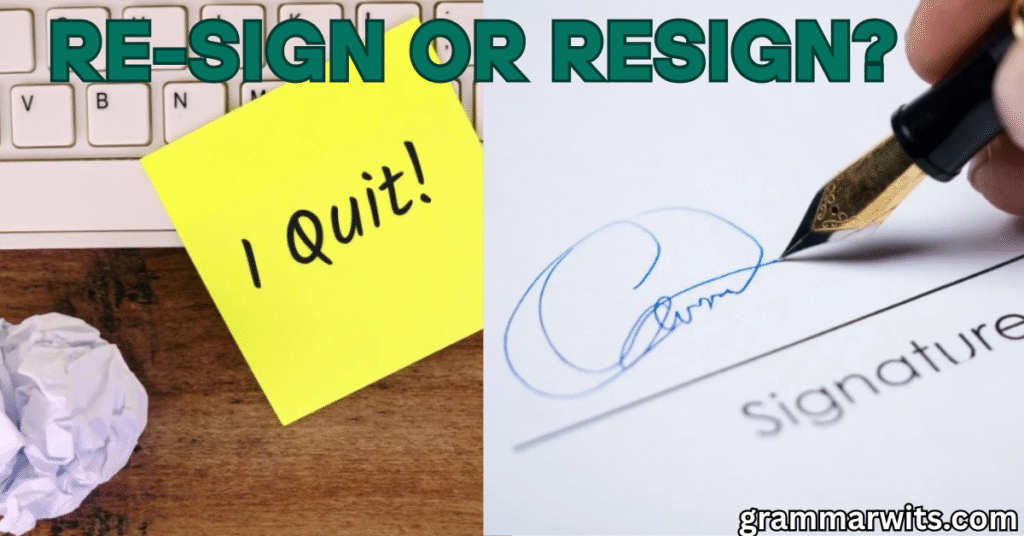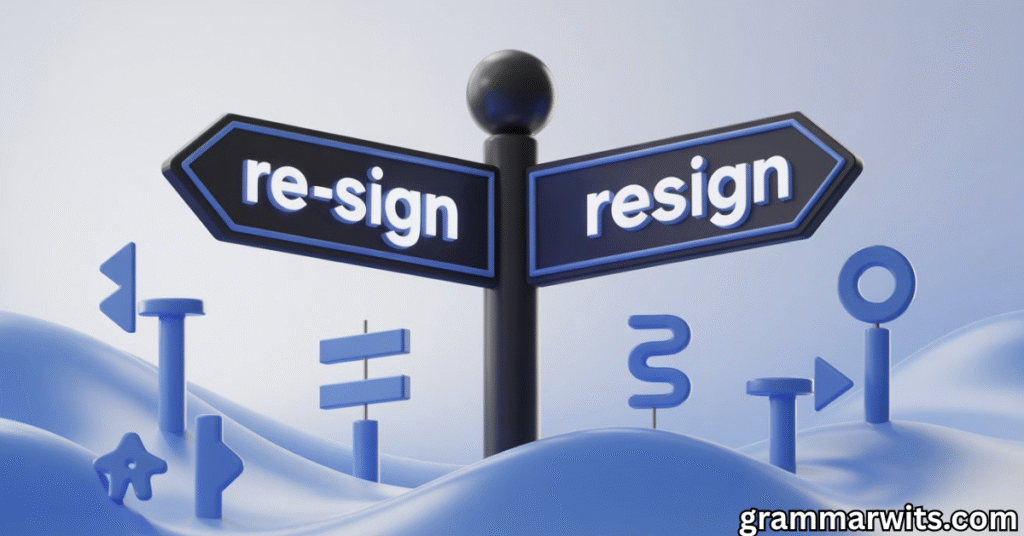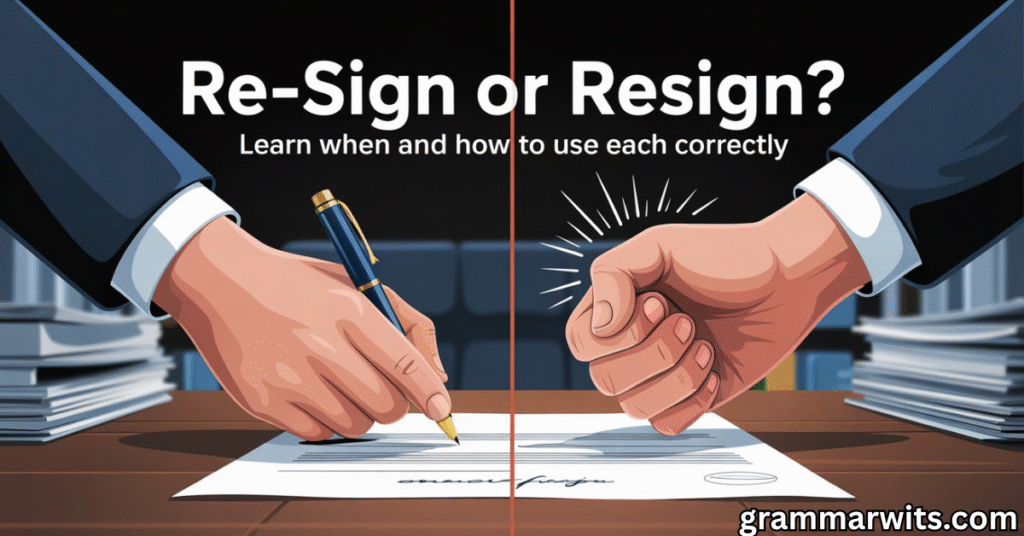The terms re-sign and resign may look nearly identical, but their meanings couldn’t be more different. Re-sign—with a hyphen—means to sign again, usually to extend or renew a contract, agreement, or position. In contrast, resign—without a hyphen—means to voluntarily leave a role or step down from a job or responsibility. This minor visual detail—a single hyphen—completely shifts the intent behind the word, making it essential to understand and use each correctly. The article titled Re-sign or Resign Learn When and How to Use helps clear up common writing mistakes.
One tiny dash can make or break the message you’re trying to send. Imagine a CEO announcing they will “resign” when they meant to “re-sign.” It could send shockwaves through a company. This small hyphen holds massive weight in both professional and everyday writing. If you’ve ever hesitated before typing either version, you’re not alone—and this guide will give you the clarity you’ve been craving.
Mastering the difference between re-sign and resign is more than just good grammar—it’s a must for effective communication. Whether you’re renewing a contract, drafting an email, or editing a formal document, understanding when and how to use each word correctly ensures that your message is precise, professional, and miscommunication-proof.
Introduction: Why These Words Trip Everyone Up

The orthographic variation between “re-sign” and “resign” might seem minor—just a tiny hyphen—but this small difference completely transforms the meaning. What makes these terms particularly troublesome is their opposite meanings despite their visual similarity.
Consider these scenarios:
- A star athlete “re-signs” with their team (continues playing for them)
- A CEO “resigns” from their position (leaves the company)
The consequences of mixing these up can be significant:
- Contract misunderstandings
- Incorrect news reporting
- Professional embarrassment
- Legal complications
As language expert Dr. James Wilson notes: “The re-sign/resign confusion represents a perfect storm of English language complexity—words that look nearly identical, sound similar, yet mean opposite things.”
This word disambiguation challenge trips up even seasoned writers and professionals. Let’s solve this problem once and for all. If you’re confused by similar-looking words, Re-sign or Resign Learn When and How to Use is a must-read.
The Critical Distinction: Opposite Meanings, Similar Spelling
At their core, these words represent fundamentally opposite concepts:
| Term | Core Meaning | Action Direction |
|---|---|---|
| Re-sign | To sign again | Continuing/renewing |
| Resign | To give up a position | Departing/ending |
The lexical semantics here couldn’t be more different. “Re-sign” suggests renewal and continuation, while “resign” indicates termination and departure. What makes these words particularly challenging is that they often appear in similar contexts—professional settings involving contracts, positions, and formal agreements.
According to a study by Grammarly, this pair ranks among the top 20 most commonly confused word pairs in business communications, alongside classics like “their/they’re/there” and “affect/effect.”
The contextual meaning is everything. Without understanding the situation, readers may completely misinterpret messages containing these terms.
Re-sign Explained: Committing Again
“Re-sign” functions as a verb meaning “to sign again” or “to commit to a new period of agreement.” This hyphenation is critical as it signals the prefix “re-” (meaning “again”) combined with “sign.”
When should you use “re-sign”?
- When someone extends a contract
- When an agreement is renewed
- When a commitment is formalized for another term
The morphology of “re-sign” clearly indicates its meaning: re- (again) + sign (to affix a signature). The hyphen serves as a crucial visual and cognitive separator, preventing confusion with “resign.”
Re-sign appears frequently in:
- Sports reporting: “The team hopes to re-sign their star quarterback.”
- Business contexts: “We’re pleased to announce that Dr. Smith has agreed to re-sign her consulting agreement.”
- Entertainment industry: “The actress will re-sign for three more seasons.”
- Academic settings: “Professor Johnson will re-sign her research grant next week.”
“The hyphen in re-sign isn’t optional—it’s essential. Without it, you’re communicating the opposite of your intention.” — The Chicago Manual of Style editor
Resign Explained: Walking Away

“Resign” is a single, unhyphenated word meaning “to voluntarily leave a position” or “to give up an office or job formally.” Its contextual usage patterns typically involve professional departures. Teachers often recommend Re-sign or Resign Learn When and How to Use to explain the power of a hyphen.
When “resign” is the appropriate term:
- When someone is stepping down from a position
- When an official is leaving office
- When an employee is quitting
- When someone is surrendering a role
Unlike its hyphenated counterpart, “resign” comes from different etymological roots (we’ll explore this later) and conveys a sense of finality. The decision to resign often represents a significant life or career transition.
Common contexts for “resign”:
- Corporate announcements: “The CFO will resign effective immediately.”
- Political news: “The minister has decided to resign following the controversy.”
- Chess: “After losing her queen, she knew she would have to resign soon.”
- Personal career decisions: “After ten years with the company, I’ve decided to resign.”
The syntactic clues around these terms often help identify which is correct. Words like “from,” “position,” and “role” frequently follow “resign,” while “with,” “for,” and “to” often appear near “re-sign.”
The Pronunciation Key: How They Sound Different
Despite looking similar on paper, these terms have distinctly different pronunciations—a phonetic similarity that still maintains crucial differences:
- Re-sign: /ˌriːˈsaɪn/ (emphasis on “sign” with a slight pause after “re”)
- Resign: /rɪˈzaɪn/ (emphasis on “zign” with no pause)
The difference becomes clear in these components:
- Re-sign has a more pronounced “e” sound in “re” and a tiny pause before “sign”
- Resign flows as one continuous word with a “z” sound instead of “s”
This pronunciation difference can be your auditory clue when speaking or listening. If you hear someone say “re-sign” correctly, you’ll notice that brief pause where the hyphen exists in writing. You can improve your writing clarity with Re-sign or Resign Learn When and How to Use as a reference guide.
Regional variations exist, but the fundamental distinction remains consistent across English dialects. In British English, American English, Australian English, and other variants, speakers maintain this pronunciation difference.
How to Remember the Difference: Foolproof Techniques

Mastering the distinction between these terms requires reliable memory techniques. Here are some proven strategies:
The Prefix Method: Remember that “re-” as a prefix typically means “again” or “back”:
- Re-do = do again
- Re-build = build again
- Re-sign = sign again
The Opposite Directions Technique:
- Re-sign = moving toward continued commitment
- Resign = moving away from commitment
The Visual Hyphen Cue: Picture the hyphen in “re-sign” as a connector joining two periods of commitment together.
Practical exercise: For each sentence below, determine whether “re-sign” or “resign” is correct:
- After careful consideration, the CEO decided to _____.
- The player and his agent hoped to _____ with the team.
- Due to health concerns, she will _____ from her position.
- They were excited to _____ their lease for another year.
(Answers: 1. resign, 2. re-sign, 3. resign, 4. re-sign)
Real-World Examples: “Re-sign” in Action

Sports Contracts:
- “The Chicago Bulls hoped to re-sign Michael Jordan after each championship season.”
- “After testing free agency, Tom Brady decided to re-sign with the Patriots before eventually joining Tampa Bay.”
Business Agreement Renewals:
- “The startup was thrilled when their anchor client agreed to re-sign for another year of services.”
- “We’ve successfully negotiated to re-sign our office lease at favorable terms.”
- “The network announced that the popular host would re-sign her contract for five more seasons.”
- “After lengthy negotiations, the entire cast agreed to re-sign for the sequel.”
Government Appointments:
- “The administrator will re-sign her appointment to the commission next month.”
- “Both parties urged the judge to re-sign to another term on the bench.”
Case Study: The Costly Re-sign/Resign Typo In 2018, a minor league sports organization issued a press release stating their star player had “resigned” when they meant he had “re-signed.” Several news outlets reported his departure, causing confusion among fans and requiring a clarification statement. The organization later implemented a mandatory editorial review process for all contract announcements. The blog post Re-sign or Resign Learn When and How to Use uses examples to teach correct word usage.
Real-World Examples: “Resign” in Action

Professional Resignation Letters:
- “It is with mixed emotions that I resign from my position as Marketing Director.”
- “Please accept this letter as formal notification that I am resigning from my position effective two weeks from today.”
Political Resignation Announcements:
- “The scandal-plagued governor finally decided to resign rather than face impeachment.”
- “After the controversial vote, three board members chose to resign in protest.”
Corporate Leadership Changes:
- “The company’s stock price rose 5% after the underperforming CEO resigned.”
- “Following the merger, the CFO has decided to resign to pursue other opportunities.”
Historical Resignation Examples:
- “Richard Nixon resigned the presidency on August 9, 1974, following the Watergate scandal.”
- “Pope Benedict XVI shocked the world when he resigned in 2013, the first pope to do so in nearly 600 years.”
These examples demonstrate the contextual usage patterns that typically surround each term. Note how “resign” is frequently followed by phrases like “from my position,” “the presidency,” or other indicators of departing a role. Many people bookmarked Re-sign or Resign Learn When and How to Use to avoid embarrassing grammar errors.
Beyond the Basics: Similar Terms in the Word Family
The confusion extends beyond just the basic verbs to their various forms:
Noun Forms:
- Resignation (act of resigning) vs. Re-signing (act of signing again)
- “Her resignation was unexpected” vs. “The re-signing of the contract took place Thursday”
Past Tense and Adjective Forms:
- Resigned vs. Re-signed
- “He resigned last week” vs. “She re-signed her contract last week”
- “He had a resigned expression” (appearing accepting of an unpleasant situation) vs. “The re-signed agreement” (an agreement signed again)
Present Participle:
- Resigning vs. Re-signing
- “She is resigning tomorrow” vs. “They are re-signing their best players”
This inflectional forms distinction shows how the confusion permeates throughout all variations of these terms. The part-of-speech distinction remains consistent: both can function as verbs, and their derivatives can serve as nouns, adjectives, or present participles.
Digital Age Considerations: Email, Texting, and Autocorrect

Modern technology sometimes complicates rather than simplifies this distinction:
Autocorrect Challenges:
- Many autocorrect systems don’t recognize “re-sign” and automatically convert it to “resign”
- Some email systems strip hyphens in certain contexts
- Mobile devices may not readily offer the hyphenated version when typing
Email Signature Etiquette: When writing a resignation email:
- Clear subject lines are crucial: “Formal Resignation – [Your Name]” leaves no ambiguity
- Never use “re-sign” when submitting a resignation letter
- Always proofread carefully before sending important communications about continuing or ending commitments
Digital Communication Best Practices:
- Double-check all instances of these terms before sending
- Consider using alternative phrasing in casual contexts to avoid confusion
- When in doubt, choose clarity over brevity: “sign a new contract” instead of “re-sign”
As digital communication continues to dominate professional interactions, being precise with these terms becomes increasingly important. The tokenization challenge for natural language processing systems also struggles with these distinctions, sometimes failing to properly identify the difference in meaning. HR professionals benefit from Re-sign or Resign Learn When and How to Use when drafting job announcements.
The Etymology Factor: Origins of Both Terms
Understanding the origins of these words reveals why they’re so different despite their similar appearance:
Etymology of “Re-sign”:
- Simply combines the prefix “re-” (from Latin, meaning “again”) with “sign”
- Has existed as long as people have needed to sign things multiple times
- The hyphen emerged as a clarifying tool to distinguish it from “resign”
Etymology of “Resign”:
- From Old French “resigner” and Latin “resignare”
- Originally meant “to give up,” “to cancel,” or “to relinquish”
- Entered English in the 14th century
This semantic shift over centuries has maintained the distinct meanings while unfortunately allowing the spellings to converge in a way that creates confusion.
Interestingly, in Latin, “resignare” could actually mean both “to unseal, cancel” and “to sign back,” which may be the ultimate origin of our modern confusion. Re-sign or Resign Learn When and How to Use explains how a small hyphen can change the whole meaning.
Grammar Expert Insights: What Style Guides Say
Professional style guides offer clear guidance on handling these terms:
AP Stylebook:
- Recommends consistently using the hyphen in “re-sign” when meaning “to sign again”
- Suggests avoiding ambiguity by rewording when possible
Chicago Manual of Style:
- Maintains that the hyphen is essential for clarity
- Recommends writers consider context and reader understanding
MLA Style:
- Follows standard dictionary guidance, treating them as distinct terms
- Emphasizes precision in academic writing
International Variations:
- Both British and American style guides agree on the hyphen distinction
- Canadian and Australian guides follow similar conventions
As grammar expert Patricia T. O’Conner writes in her book “Woe Is I”: “Some distinctions in English may seem small, but they carry enormous meaning. The hyphen in ‘re-sign’ is one such critical mark that transforms meaning entirely.” If you write contracts or letters, reading Re-sign or Resign Learn When and How to Use can prevent confusion.
Test Your Knowledge: Practice Scenarios
Apply what you’ve learned with these examples. Determine whether each requires “re-sign” or “resign”:
- After winning MVP, Jordan decided to _____ with the Bulls.
- The scandal forced the minister to _____.
- We hope to _____ our lease before it expires.
- She plans to _____ from the university after 30 years.
- The company will ask executives to _____ confidentiality agreements annually.
(Answers: 1. re-sign, 2. resign, 3. re-sign, 4. resign, 5. re-sign)
Common mistake patterns:
- Using “resign” in contexts involving continuation or renewal
- Omitting the hyphen when discussing signing again
- Confusion in headlines where context might be limited
Professional editors recommend reading text containing these words aloud to catch potential errors, as the pronunciation difference can highlight incorrect usage.
Vocabulary Expansion: Synonyms and Alternatives
When precision is paramount or you want to avoid confusion entirely, consider these alternatives:
Instead of “re-sign”:
- Renew (a contract)
- Extend (an agreement)
- Commit to another term
- Sign again
- Agree to continue
- Renew commitment
- Recommit
Instead of “resign”:
- Step down
- Quit
- Leave a position
- Withdraw from office
- Vacate a role
- Relinquish duties
- Give notice
These synonym substitution options provide clarity while avoiding the potentially confusing terms altogether. In sensitive communications where any ambiguity could cause problems, these alternatives might be preferable.
“When in doubt about re-sign versus resign, consider whether a clearer alternative exists. Sometimes avoiding the problem entirely is the most elegant solution.” — Elements of Style
Conclusion: Mastering These Terms for Good
Understanding the distinction between “re-sign” and “resign” is essential for clear professional communication. Let’s recap the key points:
- Re-sign means to sign again, renew, or commit to another term
- Resign means to voluntarily leave a position or give up an office
- The hyphen in “re-sign” is not optional—it’s the critical distinguishing feature
- Pronunciation differences can help identify which term is appropriate
- Context usually provides clues about which word is correct
- When in doubt, consider using clearer alternative terms
By mastering these commonly confused terms, you demonstrate attention to detail and precision in your communication—qualities valued in any professional setting.
Remember: in writing, as in many aspects of life, small details often carry significant meaning. A single hyphen can be the difference between continuing a journey and ending one. The guide Re-sign or Resign Learn When and How to Use is simple, useful, and perfect for learners at all levels.
FAQ: Your Most Common Questions Answered
Is it always necessary to include the hyphen in re-sign? Yes, the hyphen is essential for clarity when you mean “to sign again.” Without it, you’re using a completely different word with an opposite meaning.
Can I use ‘re-sign’ in casual communication? Yes, but be aware that in quick digital communications, the hyphen might be overlooked. For absolute clarity in casual contexts, consider phrases like “sign again” instead.
How do I explain the difference to non-native English speakers? Focus on the concept that “re-” means “again,” so “re-sign” literally means “sign again.” Then explain that “resign” is a completely different word meaning “to quit.”
Are there any contexts where both could technically work? Rarely, but potentially in situations involving both ending one role and beginning another. Even then, careful writers would specify clearly rather than rely on potentially ambiguous terminology.
How do different industries handle these terms in contracts? Legal documents typically avoid ambiguity by using precise language like “renewal of agreement” rather than “re-signing.” Sports contracts often explicitly use phrases like “contract extension” alongside “re-sign.”
What’s the best way to catch these errors when proofreading? Read the document aloud, focusing on the context. Ask yourself: “Is this about continuing something or ending it?” This simple question usually clarifies which term is appropriate.

Alizy Smith is a passionate language enthusiast and the admin of Grammar Wits. With a love for wordplay, grammar quirks, and witty expressions, she’s dedicated to making language learning fun and accessible. From grammar tips to pun-filled laughs, Alizy ensures every piece of content entertains while educating — turning tricky rules into easy, enjoyable reads.
